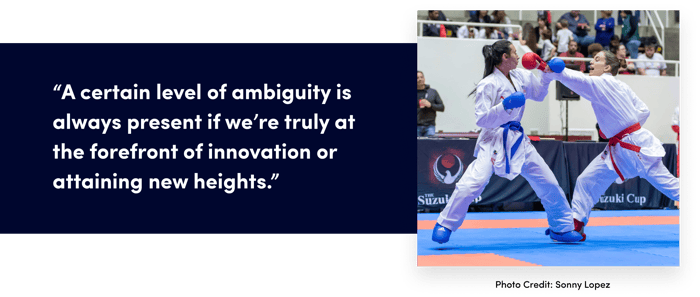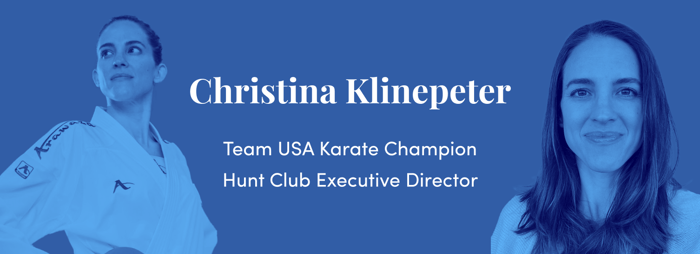
"Training for the Olympics is no small feat. With the Summer and Winter Games falling just six months apart this last year, we’ve probably all seen a recent story about the challenge and intensity of an elite athlete’s journey. I experienced that extraordinary adventure first-hand as a member of Team USA training to qualify for the 2020 (2021) Olympics, all while working full-time as an executive, as a parent, and being an older athlete, often competing against people nearly half my age. Balancing all of these roles at once meant I had to be organized in my professional, personal, and athletic endeavors to create success within the constraints of an extremely time-intensive five-year journey. Here are three lessons I learned along the way that directly translate to work and career performance." - Christina Klinepeter, Executive Director at Hunt Club
1. Take time to prioritize, then relentlessly focus on the top items.
Taking the time to prioritize sounds straightforward, and it really is, but the magic in the results of prioritizing lies in the discipline of doing it regularly. Much like how companies set monthly, quarterly and yearly goals or KPIs, we can apply this same practice to our individual work and lives. We all know that time and energy are finite, and prioritizing helps us allocate our resources according to what’s most important right now.
When in ‘planning mode,’ look at the big picture. When in ‘doing mode,’ focus on the present – this day, hour, minute, or even second. The act of prioritizing is an art, and we may not get it right every time, but with enough practice comes true progress. And over time, we'll be able to see how our habit of prioritizing adds up to accomplishing our goals.
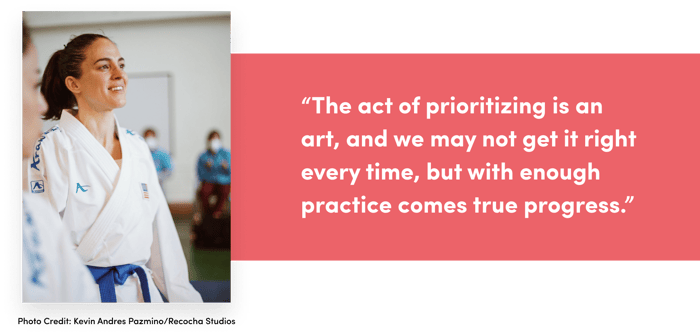
When I set out to become an Olympian in my life-long sport of karate, I was already a mom and executive. Honestly, I wasn’t sure how I would fit training into my already busy life. But I knew I had to make it a priority, so I started with one practice a week, and then two, and eventually made my way up to about 9 or 10.
At the very beginning of my journey, a friend gave me a journal that helped me create priorities every day. I made a habit of setting intentions in the morning and then reflecting on how I did at the end of the day. I also used a cognitive behavioral therapy technique to reframe one thing I would do differently each day. The whole process took just a few minutes, but it set my trajectory toward accomplishing significant goals over time. Small steps to accomplish big things! A graphic I recently saw by Liz Fosslien (@lizandmollie on Instagram) perfectly visualizes this concept.
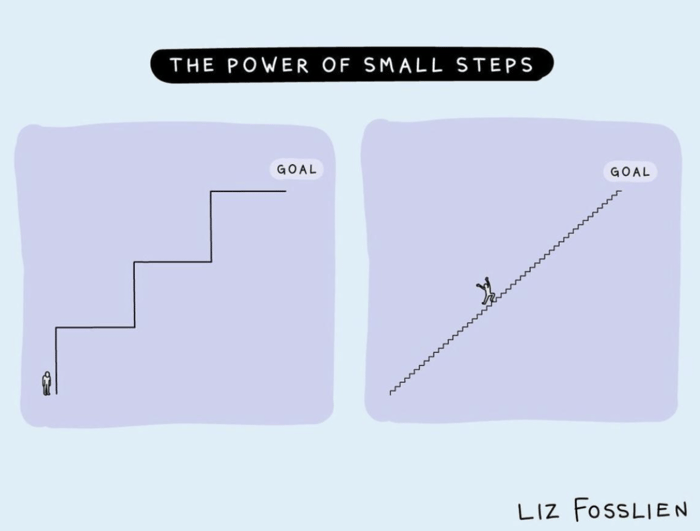
Setting our daily intentions, prioritizing our time to accomplish them, being disciplined in the small things, learning and adjusting along the way, and building daily habits can take us where we want to go in order to achieve the big goals we all dream of.
In life’s most intense seasons, it’s easy to feel like there’s never enough time to accomplish all that we want or need. But small steps every day will add up, and over time we will be able to see our progress.
2. Control the controllables
When we’re trying to achieve big goals, like reaching high-growth revenue targets, company OKRs, or even finding a new job, there isn’t always a neat and orderly path to accomplishing the mission before us. A certain level of ambiguity is always present if we’re truly at the forefront of innovation or attaining new heights.
Addressing fear with focus
It can be easy to focus on the unknown or let fear distract us and eat up our time and energy. Instead, we can turn our attention to action items or efforts that are actually in our control. By focusing on what is within our control we can better manage our time and energy, and we can make progress toward reaching our goals. The bonus of implementing this approach is that often during our efforts of chipping away at the action items within our purview, some of the ambiguity will sort itself out, become smaller, or become clearer.
Before working at Hunt Club as an Executive Director of Talent Strategy, I was CEO of a food tech delivery startup and simultaneously training for the Olympics. There were many moments when I was facing a lot of uncertainty – about how I would get everything done, how results would pan out, how I would perform, what would happen, and on and on. I remember one day I was chatting with my strength and agility coach between sets, and he shared a phrase that reframed my thoughts and energy. He encouraged me to simply “control the controllables.” I learned that this phrase is often used in the military as well as in the athlete community. Since then “control the controllables” has become a mantra of mine that I lean on to focus my attention and manage my energy. …not that I do this perfectly – I don’t. But I set my intention, and I try, and I am better for it.
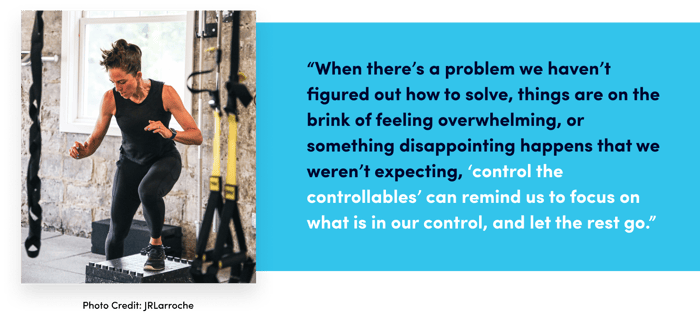
The controllables usually include how we spend our time, effort, and energy, how we communicate, how we react, and what we think (our mindset). If we are in business development or looking for a job, we can control how many outreach emails we send, but we can’t control the number of emails we get back. We can’t control how someone responds to us, but we can control our response to them or the situation. When there’s a problem we haven’t figured out how to solve, things are on the brink of feeling overwhelming, or something disappointing happens that we weren’t expecting, “control the controllables” can remind us to focus on what is in our control, and let the rest go.
Training our mindset
Now that I’ve held on to this phrase for a while, I’ve learned that often we can control (or influence) more than we initially might think is possible. For example, a huge part of what we can control is our mindset. The human brain is naturally wired for safety. We’re wired to be fearful because this is what has protected us in the past, both in our own lives and in the earlier stages of humanity. But we can challenge what we subconsciously interpret as fear and safety. When we train and manage our mindset, we can rewire our natural, suboptimal reactions and discover new heights along the way (do a quick Google search on polyvagal theory and how to map your nervous system if you want to nerd out on this).
I’m also realizing that at times, more is outside of our control than we’d like to believe. For instance, we can’t always control outcomes, but we can always control our effort and energy in the pursuit of a desired result. Think about athletes that win gold at the Olympics or even those that make it to the Games. For the vast majority, winning comes down to circumstances lining up perfectly on that exact day at that exact time. On a different day, with the same athletes and the same set of circumstances, a different athlete may come out on top.
In life, in work, in sports, there’s always an element of luck that either plays out in our favor or doesn’t. When we focus our attention on controlling the controllables, we can know that we’ve done everything in our power to accomplish what we want to achieve. Often, we’ll reach our goal. And if we don’t? We’ll learn from the experience and potentially discover something even better along the way.
3. Manage your energy & build in time to recover
Success is a marathon, not a sprint. So finding a flow that helps us manage our energy efficiently can mean the difference between reaching our goal or falling short. This process of optimizing can take time and requires patience with ourselves and those around us.
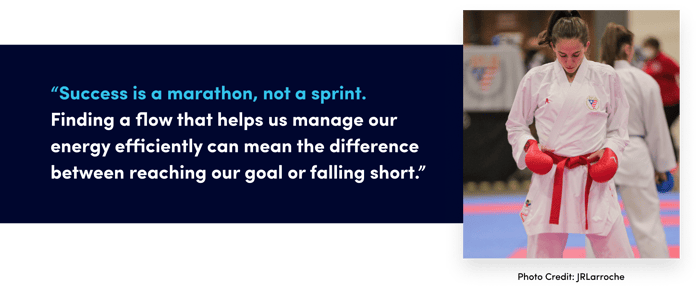
Designing our calendar for flow
I studied design in school and started my career as a graphic designer at a global, award-winning architecture and engineering firm. I happened to be part of the cross-functional team that designed and built Burj Khalifa (the tallest building in the world) when the city of Dubai was mostly a desert. I got to witness an iterative design process first-hand at the highest level (literally and figuratively). When we’re creating something functional and beautiful, adjusting and iterating is always part of the process to achieve world-class results. I use this same design process in all areas of life, but specifically to manage my energy, allowing time for both productivity and recovery to create optimal efficiency and sustainability.
My process for this is pretty simple, really. I begin with some helpful, guiding questions such as: What adds energy? What takes energy? When am I most inspired and when do I find it easiest to take care of administrative action items? Then I layer on the science around rest and the daily rhythms when we do our best work (creative in the morning, relational in the afternoon). Last, I build my schedule around those natural cycles of momentum, as much as possible. I literally put blocks on my calendar in an attempt to achieve optimal flow.
Obviously, this type of planning is idealistic and not always possible. There are times we just need to get the work done no matter what time of day it is or how it falls on the calendar. There are also times that we need to fly by the seat of our pants. In these instances, we can still find ways to tweak in order to improve our efficiency. And when we are struggling with motivation? We can find ways to trick ourselves into starting a dreaded task and reward ourselves if necessary. Then, once we’ve pushed, we can rebalance ourselves and refill our energy tanks.
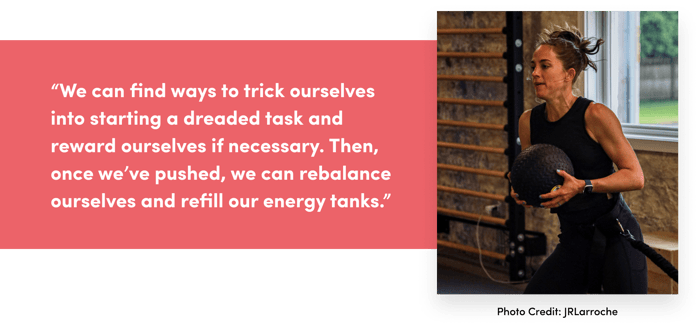
We’re only as good as we recover
As an athlete, I like to say that we are only as good as we recover, but really this concept applies to all areas of life. Yes, there are some hacks to recover as quickly as possible, but for the most part, recovering takes time and we must invest in it to perform at our best on a regular basis. By resting, disconnecting, and intentionally engaging in activities and practices that fill us up, we will reap the benefits of increased productivity.
When I was a year into my Olympic journey, I tore my ACL at an international competition. I was still jet-lagged from another international competition that was a continent away the weekend before. I was running on fumes – 5 to 6 hours of sleep a night, working more than full-time at a global not-for-profit, parenting my two young boys… you get the point. Tearing my ACL was gut-wrenching. It happened when my opponent struck my knee in a freak accidental move. When I first found out that it was a full tear, which would require surgery and months of recovery time, I thought my Olympic dream was over. But I put the work in, was strategic with my recovery, and I came back stronger and better months before the average recovery time for ACL reconstruction. It took tearing a ligament in my knee for me to take recovery and sleep seriously.
The truth is simple – we perform better when we’re rested. Yes, we can shortcut or hack this occasionally (I do LOVE coffee, just saying!), but being able to operate in a way that is optimal and sustainable, ultimately produces better results in the end and for the long term.
Doing good work is fulfilling. We don’t have to be pursuing the Olympics or be a CEO for it to matter. True success and excellence in our craft takes time. The pursuit is not about perfection, but about doing our best. We don’t have to be the best to do our best.
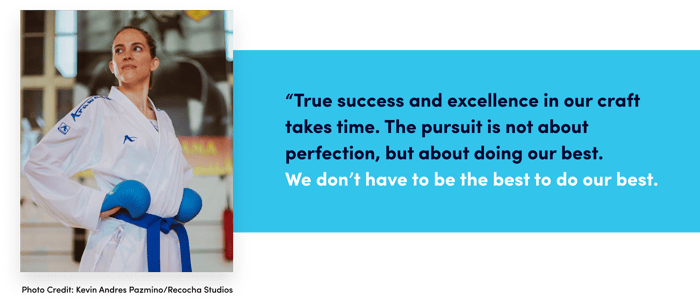
So, you may be wondering how my Olympic journey ended. After spending five years traveling the world and representing our nation on Team USA, I fell just short of qualifying for the 2020 Olympic games. I retired from competition in October 2021, finishing my fighting career ranked in the top 150 in the world and third in the nation. Most importantly, I pursued a dream, gave it my best, became a better human through the process, and discovered new levels of capability and strength within myself. In the journey is the transformation.
Start where you are with what you have, and optimize along the way. Embrace the good and the hard along the path of whatever you are pursuing. Do it with the people you love. And then balance all of that grit and productivity by taking good care of yourself because you deserve it. ✌️
Looking to build a world-class team for your organization? Christina and our talent experts can help build an effective strategy to source and hire industry leaders.

